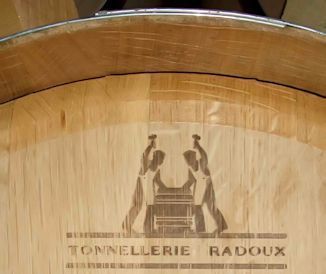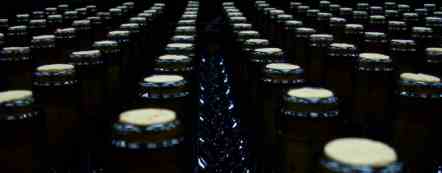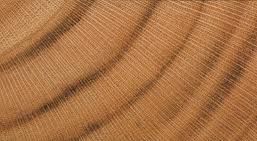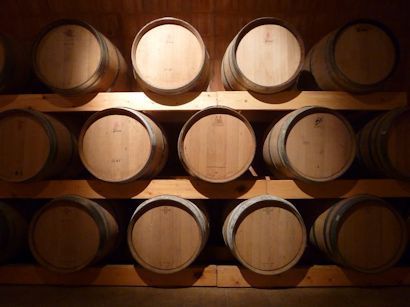Ageing
Thanks to oak ageing, wines gain balance, finesse, complexity and increase their ageing capacity.
|
During oak ageing, as time passes, barrels end up being the perfect match to give authentic character to our wines, improving for example their backbone and body. To be able to enhance the characteristics of each plot, we have in our barrel cellar a diversity of fine grain oaks (French, American and Central European) and toasting levels, as we buy our barrels from different coopers. 30% of our barrels are renewed yearly according to the standards of our quality program. |
 |
|
When ageing our wines, we look for the perfect harmony between our grape varieties and each terroir to produce unique wines. That is the reason why since our foundation in 1879, we’ve been working with different coopers to select the kind of oak that would better enhance the characteristics of each vineyard. Each plot is different and therefore, depending on the kind of wine the plot is selected for, the wine will age from 4 till 24 months before being bottled. Our underground ageing cellars were built using reinforced concrete with an automatic drainage system to better control important factors during the ageing process, such as temperature and humidity. |

Barrels
|
|
Once vinified, we select the wines of higher quality and better backbone to age them in oak. As time passes, the barrels add complexity and aromas. The newer the barrels, the faster these nuances grow. Wine and barrel harmoniously combine aromas and flavours. Part of the fruity and floral aromas diminish to grow in complexity with spicy nuances (vanilla, tobacco and many others) or even enhancing mineral notes. If the wine has the adequate backbone and quality, the longer it ages in oak, the more complex it gets with different colour shades together with a silkier and rounder mouthfeel. Full bodied wines with a lingering finish that are not easy to produce, as the key is to get the right balance. In fact, in wine history, one of the first problems winemakers had to deal with, when they started ageing wine in oak, was the stability of the wine once fermented. A real mystery, finally solved, when skilled winemakers studied and understood the importance of the malolactic fermentation. |
Once vinified, we select the wines of higher quality and better backbone to age them in oak. As time passes, the barrels add complexity and aromas. The newer the barrels, the faster these nuances grow. Wine and barrel harmoniously combine aromas and flavours. Part of the fruity and floral aromas diminish to grow in complexity with spicy nuances (vanilla, tobacco and many others) or even enhancing mineral notes. If the wine has the adequate backbone and quality, the longer it ages in oak, the more complex it gets with different colour shades together with a silkier and rounder mouthfeel. Full bodied wines with a lingering finish that are not easy to produce, as the key is to get the right balance. In fact, in wine history, one of the first problems winemakers had to deal with, when they started ageing wine in oak, was the stability of the wine once fermented. A real mystery, finally solved, when skilled winemakers studied and understood the importance of the malolactic fermentation.
The grapes we use to age wine in oak are Godello for whites and mostly Mencía for reds, even though we also have a little bit of Grenache (Alicante Bouschet). Depending on the time the wines age in barrel and the subsequent bottle ageing, they may be classified as Crianza, Reserva or Gran Reserva.
The details of the ageing process are:
Once the wines to age in oak are selected, they are gently racked off to barrels. This first step is carried out very slowly to maintain an inert atmosphere. The barrels are then closed with bungs (nowadays usually silicon bungs) and we let them settle at a temperature between 13ºC and 14ºC with a controlled humidity of at least 75%. The barrel selection (type of oak, toasting level,…) is crucial, as this will determine the characteristics of the wine and its ageing capacity. Therefore, the priority is to always get the best combination between wine and barrel.
After a few months, we decide whether we rack the wine to another barrel or leave it in the same barrel for the whole ageing process.
Barrels are usually of French, American or Central European oak with a capacity of 225 litres (Bordeaux standard barriques). The newer the barrels, the faster the wine will absorb the aromas. However, before filling the barrels with wine, we have to burn sulphur inside each one (to disinfect), as hygiene is a key factor during the whole ageing process. This step is very important, as any excess of sulphur (if we burn too much sulphur inside the barrel) will alter the taste of the wine.
When the ageing process is over (depending on whether it’s a Crianza, Reserva or Gran Reserva), the wine is racked off as many times as necessary to clean it (the wine is separated from any sediment). Then the winemaker decides on the final blend before bottling it. Once bottled, the wine has to settle and age in bottle to release its aromas and flavours and enhance its finesse. To do so, the bottles are laid down horizontally in a subterranean cellar with a controlled temperature (to avoid any fluctuation) and humidity (at least 70%).
Oak & barrels
 |
Since forever, many different types of containers and materials have been used to store and transport wine (clay pots, skins, bladders, metallic containers of different sizes,…), but very soon it became obvious that oak was the ideal and most suitable material with the first casks, which were much bigger than the current barrels. Time and experience proved oak to be the best material. Simply due to a logistical reason, the first oak containers (casks) ended up being cylindrical and convex in their central part in order to be able to transport the larger quantity of the cherished liquid. Later on, the size of the casks started diminishing in order to convert what initially was only a container into a way to improve wine with the oak characteristics and aromas. Their peculiar shape allows a person to easily roll them from one place to another. Moreover, the lateral lids simplify barrel stacking, as they are smaller than the central part of the barrel and are fitted a few centimetres from the border, so that they don’t stand out. |
Nowadays, the usual barrel is the Bordeaux standard of 225 litres. The most common ones are of American oak (Quercus Alba) and French oak (Quercus sessifolia, peduncolata, petraea and robur), even though Central European oak is used more and more frequently. To get their particular convex shape, the staves of oak must be exposed outdoor (rain and sun) during 3 years to dry and get rid of unwanted elements. This step is called “seasoning”. The staves are then dried in special dryers to eliminate any eventual humidity. Then starts the traditional manufacturing.
No glue, no cloves, nor screws are used to put the staves together. The staves are bent and burnt inside over an open fire, so that they get more flexible and get the desired toasting level. They are held together with iron rings (also called metal hoops) on both ends to get their peculiar cylindrical and convex shape. This step is carried out over an open fire to toast the inside and soak the outside so that they curve properly thanks to the natural flexibility of the oak and the skilled hands of the cooper. The additional purpose of this toasting is to give a specific character to the barrel that will then give special nuances to the wine. The higher the toasting level and the longer the ageing, the stronger the nuances.
Therefore, barrels have two fundamental purposes: as a container to store the wine and as a way to improve the ageing process to add complexity, aromas and flavours to the wine. However, nowadays that stainless steel tanks are perfect containers, barrels are really intended to enhance specific characteristics with a perfect ageing.
As mentioned, it’s been a long way to the current Bordeaux standard barrique. Among all materials, oak is the one with the best characteristics. Oak is flexible and almost waterproof, so that the oxygen diffusion through the pores of the oak is minimal and therefore won’t spoil the wine inside the barrel. The same way, the quantity of wine that evaporates is also very small. Therefore, during the whole ageing process, barrels allow a tiny quantity of oxygen to go through its pores in addition to all the aromas, flavours and complexity of the oak.
Thanks to the oak ageing, wines become softer and silkier combining different aromas of oak (cedar, pencil,…), spices (vanilla, clove, pepper, nutmeg,…) together with caramelized hints, smoky notes and nuances of dried fruit due to the toasting level. Usually wines aged in American oak are creamy with coconut hints and less dry on the palate than the ones aged in French oak. However, even though French oak adds spicy notes, it usually respects more the characteristics of each variety and terroir.
Therefore, to make it short, ageing is an almost magical process that converts strong and rough wines into round and well-balanced wines with fine aromas.
 Paseo de la constitución 106. 24540 Cacabelos (León) Spain
Paseo de la constitución 106. 24540 Cacabelos (León) Spain +34
+34 
 vinosdelbierzo
vinosdelbierzo



